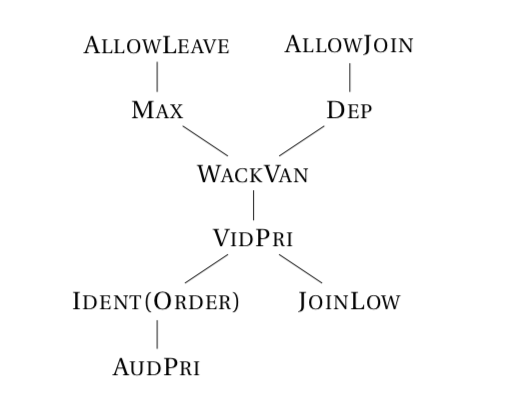EDITOR’S NOTE: MODELING ZOOM LINEARIZATION IN OT
To celebrate the conclusion of a quarter on working on Zoom, members of the graduate Field Methods course have become intimately familiar with the empirical contours of user linearization in the software. For general edification, they present the following Hasse diagram modeling the data they have observed. Note that their present proposal for the model is based on derivational uses of OT, with inputs as pairs of a previous linearization and a single-argument operation like JOIN(user), LEAVE(user), MUTE(user), and so on. Constraints are defined below.
- AllowJoin assigns one violation for every argument of a JOIN operation in the input which is not present in the output.
- AllowLeave assigns one violation for every argument of a LEAVE operation in the input which is present in the output.
- Max assigns one violation for every user in the input who is not present in the output.
- Dep assigns one violation for every user in the output who is not present in the input.
- Wackernagel’sVanity (WackVan) assigns one violation for every user with value [+self] who does not have peninitial order in the output.
- VideoPriority (VidPri) assigns one violation for every pair of users (α,β) where user α has value [-video] and user β has value [+video] and user α is linearized before user β in the output.
- AudioPriority (AudPri) assigns one violation for every pair of users (α,β) where user α has value [-audio] and user β has value [+audio] and user α is linearized before user β in the output.
- JoinLow assigns one violation for every pair of users (α,β) where user α is not present in the input linearization and user β is, and user α is linearized before user β in the output.
- Ident(Order) assigns one violation for every pair of users (α,β) where the relative order of user α and user β differs between input linearization and output linearization.
Familiar Zoom users may note that this captures handily a few odd patterns:
- New members of a chat will join to the right of all current members with video on, but to the left of those who have video off;
- Members with video off are ordered based on when they turned video off;
- Audio muting has no effect on linearization;
- The linearization displayed varies from user to user, with all users seeing themselves in second position.
Tableaux arguing for the ranking above will undoubtedly be given in the authors’ forthcoming LingBuzz manuscript, please stay tuned. In the meantime, you can direct any comments and data troublesome for this account to the WHASC editorial team.
